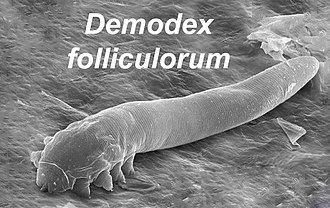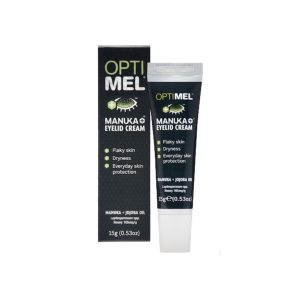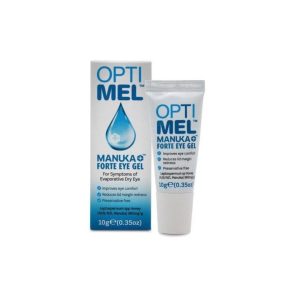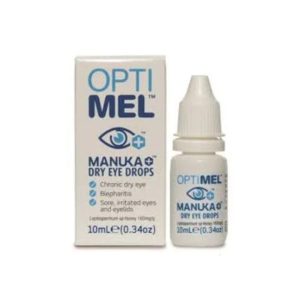Are you experiencing persistent dryness, irritation, or discomfort in your eyes?
It’s possible that you are among the many individuals affected by a chronic dry eye condition linked to Demodex mites. These tiny, eight-legged organisms naturally inhabit the skin of all humans, particularly around the eyes and eyelids. However, when their population exceeds normal levels in certain individuals, it can lead to inflammation that intensifies the symptoms of dry eye.
If you’ve been battling unexplained dry eye issues, it’s crucial to explore whether Demodex mites could be contributing to your discomfort.
In this comprehensive guide, we’ll help you identify the signs of a Demodex infestation, explain how these mites play a role in causing dry eye disease, and discuss effective treatment strategies to manage their population.

Recognizing the Signs of Demodex Blepharitis
Individuals suffering from Demodex Blepharitis or an excessive population of these mites around their eyes often find themselves facing a range of characteristic symptoms. These can include:
- Burning, stinging, or gritty sensations in the eyes, particularly noticeable towards the end of the day.
- Unexplained excessive tearing or watery eyes that are not caused by allergies.
- Red, inflamed eyelids, along with irritation of the skin surrounding the eyes.
- Crusty, dandruff-like buildup along the lashes and lid margins, often manifesting as collarettes.
- Extreme sensitivity to light, making it feel as if your eyes are constantly squinting.
- Episodes of blurred vision that fluctuate throughout the day.
Many individuals endure these dry eye symptoms for years without recognizing that an infestation of Demodex mites could be a significant underlying factor.

Understanding the Mechanism Behind Demodex Mites and Dry Eye Symptoms
Wondering how these microscopic creatures can lead to such distressing dry eye symptoms? Demodex mites thrive on skin oils and cells, making their home in the hair follicles of your eyelashes. As they feed, their waste products, eggs, and deceased mites accumulate along the lid margins, creating a thick layer of debris and bacterial biofilm that obstructs the delicate oil glands essential for eye health.
When the oil glands fail to release adequate oils necessary to maintain the eye’s tear film, dry patches can form rapidly. This oily tear film is vital for preventing the swift evaporation of the watery tears that keep our eyes moist and comfortable.
This inflammation can further exacerbate eye irritation, redness, and that uncomfortable gritty sensation associated with dry eye.
Exploring the Life Cycle of Demodex Mites
Grasping the life cycle of Demodex mites is essential for effective treatment. These mites undergo distinct stages: egg, larva, nymph, and adult, during a life cycle that lasts between 14 and 21 days. They are most active at night, leaving their hair follicles to mate and deposit new eggs on the skin’s surface.
This nocturnal activity suggests that the optimal time for administering Demodex treatments is in the evening, just before bedtime. By targeting the mites when they are most active, it becomes easier to eliminate them. However, due to their swift reproductive rate, any surviving mites can quickly repopulate, making ongoing treatment essential over several weeks or months.
Effective Strategies for Treating Demodex-Related Dry Eye
If your optometrist identifies a high count of Demodex mites through eyelash sampling or microscopic examination, they may recommend various treatment methods to address the infestation:
1. Utilizing Tea Tree Oil Eyelid Wipes and Scrubs
Solutions containing tea tree oil exhibit powerful antimicrobial and antiparasitic properties, which can effectively eradicate mites. These solutions can eliminate surface mites, break down collarettes produced by these pests, and draw out buried mites, putting them in a more vulnerable position.
While tea tree oil is potent against mites, it can cause stinging upon application and may be cytotoxic to healthy cells, potentially inflaming and worsening symptoms for certain patients.
Daily application of tea tree oil eyelid wipes or scrubs before bedtime can gradually decrease the mite population. One example of a highly effective tea tree oil treatment is OcuSoft Oust Foam, which is particularly beneficial for managing blepharitis primarily caused by Demodex mites.
2. Gentle Hypochlorous Acid Lid Hygiene Sprays
Hypochlorous acid is naturally produced by our immune system and serves as an effective antimicrobial agent. It is gentle on the eyes, does not cause stinging, and is safe for our cells.
Disinfecting lid sprays and cleansing foams containing hypochlorous acid not only kill mites but also reduce inflammation and provide relief from symptoms.
Applying these solutions to the lash lines before bed can effectively eliminate mites and their debris. These products often have a distinct odor reminiscent of chlorinated pool water. Examples of hypochlorous acid-based solutions include Ocusoft Hypochlor Spray and Avenova.
We often recommend Ocusoft Hypochlor Foam due to its superior value, featuring an extended shelf life after opening.
3. Harnessing the Power of Manuka Honey Solutions
Research suggests that Manuka Honey solutions can be as effective as 50% tea tree oil against Demodex, although further studies are required in this area. While it may cause a slight sting upon application, Manuka Honey is less effective than tea tree oil specifically against Demodex, yet it shows excellent efficacy against other types of blepharitis. It is not cytotoxic and is less likely to induce inflammation in the eyelids.
Patients often report that the initial sting is worth it, as they experience significant relief afterward. Manuka Honey solutions come in gel form (like Optimel Forte, which is more effective but stings more) and as drops (like Optimel Drops, which are easier to apply and sting less).
4. Addressing Severe Demodex Infestations with Oral Anti-Parasitics
In cases where Demodex overpopulation is severe and persistent, healthcare professionals may prescribe oral antiparasitic medications. Medications such as Ivermectin in pill form have proven effective for managing these infestations, as have weekly doses of oral tea tree oil supplements taken over several months to help keep mite levels in check.
5. Professional Treatments for Effective Demodex Management
Certain eye clinics provide intensive in-office treatments specifically designed for Demodex management, utilizing products such as Oust Demodex Cleanser Swabstix or a specialized hand-held electric brush known as BlephEx.
The Oust Demodex Cleanser Swabst
Comments are closed






It’s fascinating how often we overlook the tiniest things in our lives—like Demodex mites—that can have such a significant impact on our health. I’ve personally dealt with chronic dry eye for years and never considered that it might be related to these little creatures. It raises an important point about the balance of our microbiome, not just on our skin but also in our eyes.
You’re touching on something that many of us forget in our daily lives—the little things often have a larger role than we realize. Demodex mites are just one of those elements that quietly coexist with us, yet they can have a noticeable impact when we’re not mindful of our overall microenvironment. Chronic dry eye can be frustrating, especially when you’ve been dealing with it for years without a clear understanding of its causes.
It’s interesting to see the connection between Demodex mites and dry eye symptoms being highlighted. I have personally struggled with chronic dry eyes for years, and it often felt like an ongoing mystery. Initially, I never considered parasites might be a factor. The idea that these mites could trigger such inflammation definitely opens up a new avenue of understanding for many who have been brushing off their symptoms as mere dryness or fatigue.
It’s definitely a topic that’s gaining traction these days. The connection between Demodex mites and dry eye symptoms is something many people probably overlook. I can see how the idea of parasites playing a role adds a layer of complexity to understanding chronic dry eye. It’s fascinating how such tiny organisms can impact our well-being in significant ways.
It’s fascinating to hear about your experience with chronic dry eyes. Many people, like you, often overlook the role that tiny creatures like Demodex mites can play in our overall eye health. These mites are so small that we can barely see them, but they can create a surprising amount of trouble, especially when they multiply and lead to inflammation.
I can relate to your experience with chronic dry eyes—it’s frustrating when you’re searching for answers, and the connection to something like Demodex mites doesn’t typically come to mind. It’s fascinating how often we overlook the role of microscopic organisms in our everyday health issues.
I completely understand that feeling of frustration when dealing with chronic dry eyes. It’s surprising how often the root causes of our ailments can be tied to such tiny, often overlooked organisms like Demodex mites. Until I stumbled upon this connection myself, I didn’t realize how much our health could be influenced by the microscopic world around us.
It’s interesting to see how our everyday health can be influenced by something as tiny as Demodex mites. I learned a bit about these little critters when I was struggling with persistent eye issues a while back, and it was shocking to realize they were lurking right under our noses. I had never thought of them as potential culprits for my dry eyes!
It’s fascinating how something so small can have such a significant impact on our health, isn’t it? I remember reading about Demodex mites and thinking how they’re a natural part of our ecosystem, yet so much goes unnoticed until it starts affecting us directly. Your experience with dry eyes highlights how interconnected our body systems really are—problems we might think are unrelated can often draw connections with these tiny organisms.
I totally relate to your experience; it’s intriguing how our little skin dwellers can impact things like dry eyes, and I recently came across some really helpful makeup tips that cater to sensitive skin.
‘New Cosmetics for Dry Eyes: Makeup Tips for Sensitive Skin’
https://writebuff.com/new-cosmetics-for-dry-eyes-makeup-tips-for-sensitive-skin/.
It’s really interesting how we often overlook the tiniest elements of our environment that can play such a crucial role in our health. Demodex mites, for instance, are these almost invisible inhabitants of our skin that can be perfectly harmless until they begin to cause issues, like dry eyes. It’s a reminder that our bodies are a complex web of connections, where seemingly unrelated problems can come back to something as small as a mite. I found it quite enlightening to realize how intricately everything is linked, and how one aspect of our health—like skin or eye irritation—can spiral into other areas we might not immediately connect.
It’s wild how something so small can have such an impact, right? It’s easy to overlook those tiny mites while dealing with something as frustrating as dry eyes. They’re part of our natural skin ecosystem, but sometimes their populations can get out of hand and lead to irritation. Have you looked into how lifestyle factors, like diet or screen time, might also play a role? It’s a bit of a tangled web when you think about it—all of these elements interacting without us noticing. Balancing our daily habits can sometimes make a significant difference. Would be curious to hear what steps you took to manage your eye issues.
This topic really resonates with me. I’ve struggled with dry eyes for years and never considered that Demodex mites could be a factor. It’s interesting how something so small can have such a big impact on our comfort. In my case, I’ve tried various eye drops and warm compresses, but didn’t see much improvement.
It’s really intriguing how something as tiny as Demodex mites can play such a significant role in our overall eye health. I can relate to the struggle with dry eyes; it can be frustrating to try multiple remedies and still feel like you’re not making any progress. I’ve read about other underlying factors that can contribute, like environmental conditions or even certain medications.
I totally get where you’re coming from; I recently came across some helpful makeup tips tailored for sensitive skin that might just make a difference for those of us dealing with dry eyes.
‘New Cosmetics for Dry Eyes: Makeup Tips for Sensitive Skin’
https://writebuff.com/new-cosmetics-for-dry-eyes-makeup-tips-for-sensitive-skin/.
It’s interesting how something so small, like Demodex mites, can have such a big impact on our daily lives. I used to scratch my head wondering why my eyes felt so dry all the time, and it turns out something as microscopic as these mites was the culprit. It really makes you think about how much we take our eye health for granted.
You’re right; it’s fascinating how something we can’t even see can affect our daily lives so profoundly. A lot of people don’t realize that our bodies are home to countless microorganisms, each playing a role—good or bad. It’s a reminder that our health, especially eye health, hinges on balance.
I really appreciate this in-depth examination of the connection between Demodex mites and dry eye conditions. It’s intriguing how something so small can significantly impact our health and well-being. I’ve personally struggled with dry eyes for years, often attributing it to screen time or environmental factors. I had never considered that these mites could be a contributing factor.
I found your discussion on the link between Demodex mites and chronic dry eye symptoms really insightful. It’s fascinating to think about how these tiny organisms, which we often overlook, can have such a significant impact on our comfort and well-being. I’ve personally wrestled with dry eyes for years and had never considered the possibility of Demodex mites being the culprit until recently.
It’s wild, right? Here we are, busy living our lives, and there’s a tiny army of Demodex mites hanging out on our faces like uninvited guests. I mean, who knew these microscopic critters could be such a hidden menace? They’re like the ninjas of the skin world, stealthily just chilling and stirring up trouble—especially for those of us grappling with dry eyes.